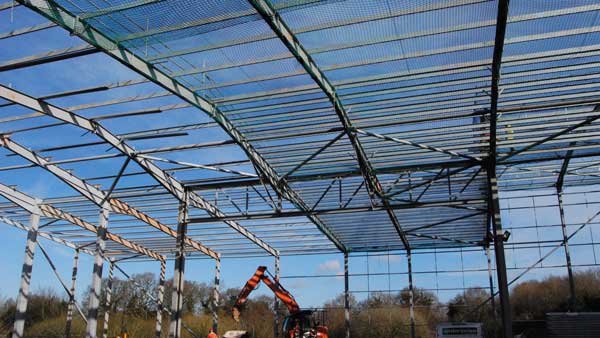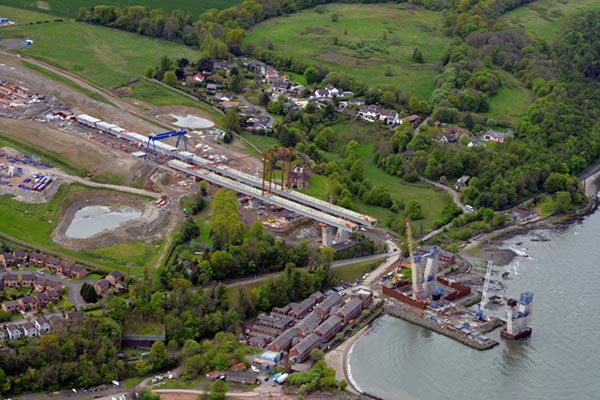SSDA Awards
Commendation: Approach Viaduct South, Queensferry Crossing
 Opened in August 2017, Transport Scotland’s Queensferry Crossing is both the UK’s tallest bridge and the world’s longest three-tower, cable-stayed bridge.
Opened in August 2017, Transport Scotland’s Queensferry Crossing is both the UK’s tallest bridge and the world’s longest three-tower, cable-stayed bridge.
FACT FILE
Structural engineer: Ramboll
Steelwork contractor: Cleveland Bridge UK Ltd
Main contractor: Forth Crossing Bridge Constructors
Client: Transport ScotlandLinking Edinburgh with Fife, the new Crossing stands proud in a unique bridgescape, alongside its illustrious neighbours, the Forth Bridge and Forth Road Bridge (FRB).
The bridge is strategically vital to Scotland. It was commissioned following revelations of potential structural compromises to the aging FRB, which were uneconomical to repair. The FRB was susceptible to weather-related closures, with a huge impact across the region.
On the south side of the crossing the approach viaduct is 545m long, consisting of twin parallel continuous composite decks with steel box sections, supported on six V-shaped piers.
The approach viaduct comprises two composite steel box girders, set 21.75m apart. These are directly connected to the main span cable-stayed single box section of the Crossing.
Steel offered the strength, lightness, versatility, durability and speed, making it an environmentally sustainable solution. Its lightness allowed a delivery solution that minimised any damaging impact on the estuary banks.
“With steep terrain making way for mud flats and shallow water on the south approach, a launched steel viaduct solution offered a number of environmental benefits, allowing us to minimise reliance on marine plant and negate the need for dredging or temporary causeways that would harm the environment,” explains Ramboll Director Steve Thompson.
 The viaduct was pre-assembled before being progressively launched into place, following the design philosophy for the entire Crossing; completing complex assembly offsite. Assembly took place in an efficient and controlled environment, keeping work out on the estuary to a minimum.
The viaduct was pre-assembled before being progressively launched into place, following the design philosophy for the entire Crossing; completing complex assembly offsite. Assembly took place in an efficient and controlled environment, keeping work out on the estuary to a minimum.
The steel twin box girders of the viaduct were fabricated and pre-assembled by Cleveland Bridge. The completed girders were transported by road in halves due to the width of the boxes.
“Behind the southern approach, we prepared a 160m long assembly platform work area. This formed the assembly and launch area for all stages,” says Cleveland Bridge Site Services Manager Mike Condren.
“As there was insufficient space to assemble the entire length of the steelwork prior to launching, we launched the east and west girders independently and alternately in six stages. This facilitated a rolling programme of fabrication, segment delivery, site assembly and a staged installation.”
The approach viaduct steel box weight is 2,600t per girder with an additional 500t for installed soffit concrete at pier support locations for the double composite action in the permanent installation.
With a further 100t for king post, stays and associated temporary works stiffening, the launch weight was approximately 3,200t per box. Ancillary items such as inspection gantry rails, internal access ways and MEP were installed after launching.
Construction of the concrete deck slab and cantilevers was undertaken in phases. All main service lines and mainline drainage are housed within the box. This offers a cleaner aesthetic while ensuring vital services can be maintained and repaired in a controlled environment.
Summing up, the judges say in a landscape comprising the Forth Bridge and the Forth Road Bridge, the new Queensferry Crossing, Britain’s tallest bridge, cannot fail to impress. This scheme for the southern approach viaduct embodies the knowledge in design, fabrication and long‐term maintenance, in the launching and finishing the twin box viaducts, from some of the world’s most accomplished bridge builders.
All images on this page © Transport Scotland













